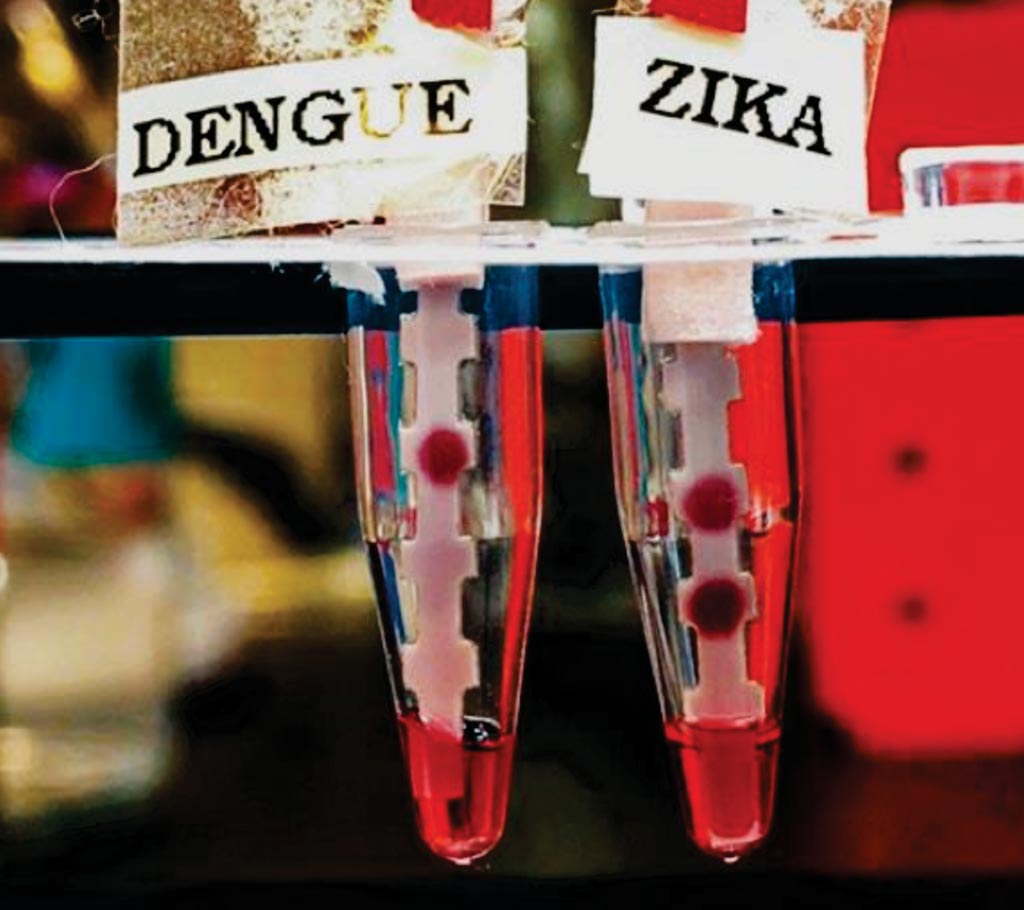Novel Immunochromatographic Method Rapidly Identifies Flaviviruses
By LabMedica International staff writers
Posted on 01 Nov 2017
The recent Zika virus (ZIKV) outbreak demonstrates that cost-effective clinical diagnostics are urgently needed to detect and distinguish viral infections to improve patient care. Unlike dengue virus (DENV), ZIKV infections during pregnancy correlate with severe birth defects, including microcephaly and neurological disorders.Posted on 01 Nov 2017
Because ZIKV and DENV are related flaviviruses, their homologous proteins and nucleic acids can cause cross-reactions and false-positive results in molecular, antigenic, and serologic diagnostics. Cross-reactivity among flaviviruses poses a conundrum because the viral protein, NS1, is very similar among dengue and Zika viruses, which are transmitted by the same types of mosquitos.

Image: Dipstick tests for dengue (left) and Zika (right) accurately identify the presence of Zika virus protein in a sample (Photo courtesy of Massachusetts Institute of Technology).
A large international team of scientists led by those at Massachusetts Institute of Technology (Cambridge, MA, USA) characterized monoclonal antibody pairs that have been translated into rapid immunochromatography tests to specifically detect the viral nonstructural 1 (NS1) protein antigen and distinguish the four DENV serotypes (DENV1–4) and ZIKV without cross-reaction. To complement visual test analysis and remove user subjectivity in reading test results, they used image processing and data analysis for data capture and test result quantification.
Overall, they tested 300 Zika combinations and 726 dengue combinations to identify antibody pairs and successfully distinguish between the four dengue serotypes and Zika viruses. The test operates similar to a pregnancy test, taking 10 to 15 minutes to provide an answer. Users add a biological fluid such as blood serum that wicks through the paper strip via capillary action, producing the results.
The team used a 30-μL serum sample, the sensitivity and specificity values of the DENV1–4 tests and the pan-DENV test, which detects all four dengue serotypes, ranged from 0.76 to 1.00. Sensitivity/specificity for the ZIKV rapid test was 0.81/0.86, respectively, using a 150-μL serum input. Serum ZIKV NS1 protein concentrations were about 10-fold lower than corresponding DENV NS1 concentrations in infected patients; moreover, ZIKV NS1 protein was not detected in polymerase chain reaction–positive patient urine samples.
Kimberly Hamad-Schifferli, PhD, an associate professor and co-author of the study said, “Among the four dengue serotypes and with Zika, they are over 70% similar in sequence, making it challenging to find antibodies that do not cross-react. The novel test is self-contained in that it does not require any additional special reagents and can be operated by a non-expert. In addition, it does not require any power for operation or readout.” The study was published on September 27, 2017, in the journal Science Translational Medicine.
Related Links:
Massachusetts Institute of Technology














